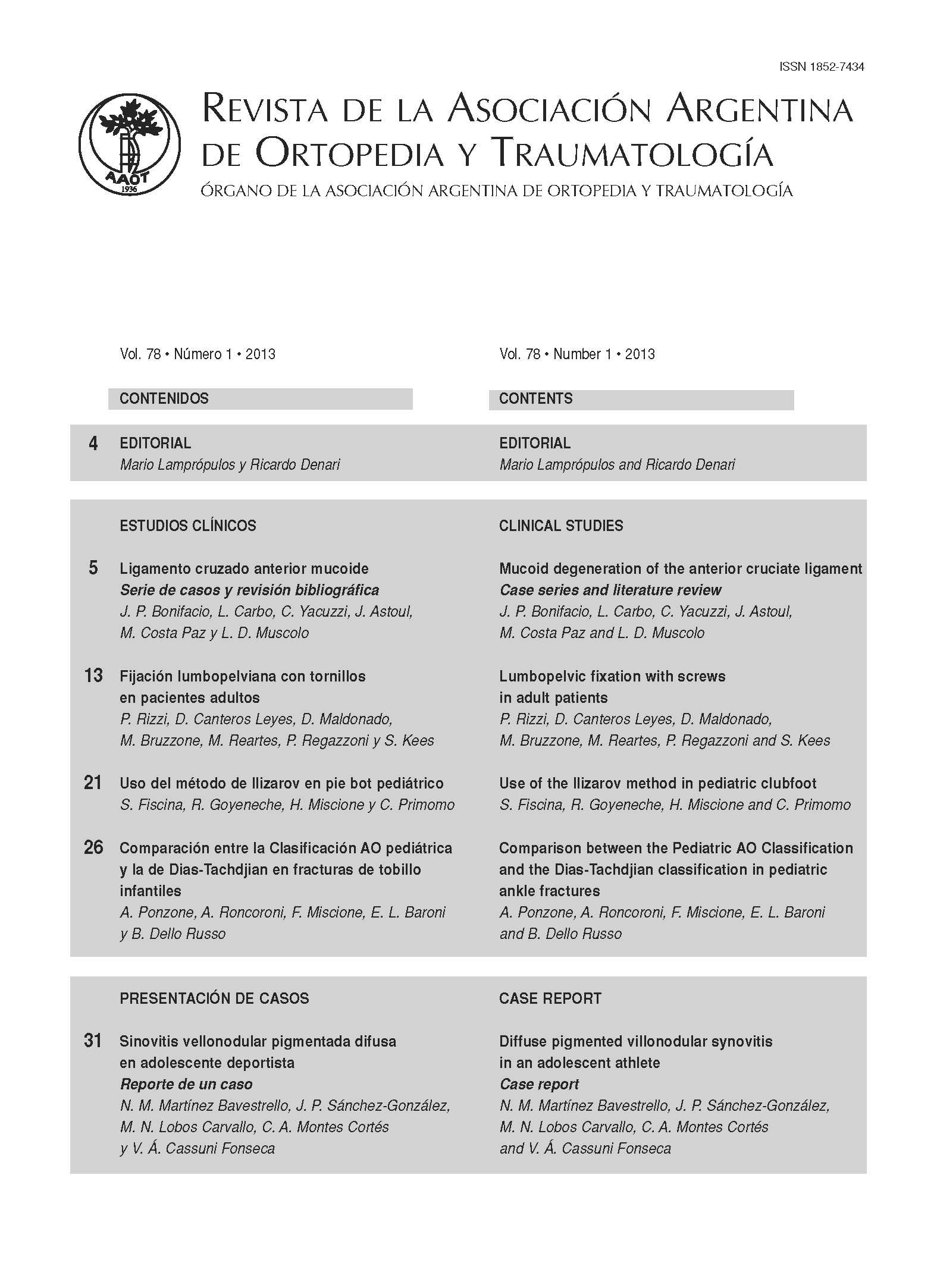Lumbopelvic fixation with screws in adult patients
Main Article Content
Abstract
Downloads
Metrics
Article Details

This work is licensed under a Creative Commons Attribution-NonCommercial-ShareAlike 4.0 International License.
Manuscript acceptance by the Journal implies the simultaneous non-submission to any other journal or publishing house. The RAAOT is under the Licencia Creative Commnos Atribución-NoComercial-Compartir Obras Derivadas Igual 4.0 Internacional (CC-BY-NC.SA 4.0) (http://creativecommons.org/licences/by-nc-sa/4.0/deed.es). Articles can be shared, copied, distributed, modified, altered, transformed into a derivative work, executed and publicly communicated, provided a) the authors and the original publication (Journal, Publisher and URL) are mentioned, b) they are not used for commercial purposes, c) the same terms of the license are maintained.
In the event that the manuscript is approved for its next publication, the authors retain the copyright and will assign to the journal the rights of publication, edition, reproduction, distribution, exhibition and communication at a national and international level in the different databases. data, repositories and portals.
It is hereby stated that the mentioned manuscript has not been published and that it is not being printed in any other national or foreign journal.
The authors hereby accept the necessary modifications, suggested by the reviewers, in order to adapt the manuscript to the style and publication rules of this Journal.
References
2. Zheng ZM, Yu BS, Chen H, Aladin DM, Zhang KB, Zhang JF, et al. Effect of iliac screw insertion depth on the stability and strength of lumbo-iliac fixation constructs: an anatomical and biomechanical study. Spine (Philadelphia) 2009;34(16):E565-72.
3. Bridwell KH. Utilization of iliac screws and structural interbody grafting for revision spondylolisthesis surgery. Spine (Phila Pa 1976) 2005;30(6 Suppl):S88-96.
4. Kornblatt MD, Casey MP, Jacobs RR. Internal fixation in lumbosacral spine fusion: a biomechanical and clinical study. Clin Orthop 1986;203:141-9.
5. Kuklo TR, Bridwell KH, Lewis SJ, Baldus C, Blanke K, Iffrig TM, et al. Minimum 2-year analysis of sacropelvic fixation and L5–S1 fusion using S1 and iliac screws. Spine 2001;26(18):1976-83.
6. LaGrone MO, Bradford DS, Moe JL, Lonstein JE, Winter RB. Treatment of symptomatic flat back after spinal fusion. J Bone Joint Surg Am 1988;70:569-80.
7. Pihlajamaki H, Bostman O, Ruuskanen M, Myllynen P, Kinnunen J, Kaaraharju E. Posterolateral lumbosacral fusion with transpedicular fixation: 63 consecutive cases followed for 4 (2-6) years. Acta Orthop Scand 1996;67:63-8.
8. Pihlajamaki H, Myllynen P, Bostman O. Complications of transpedicular lumbosacral fixation for nontraumatic disorders. J Bone Joint Surg Br 1997;79:183-9.
9. Schildhauer TA, McCulloch P, Chapman JR, Mann FA. Anatomic and radiographic considerations for placement of transiliac screws in lumbopelvic fixations. J Spinal Disord Tech 2002;15(3):199-205.
10. Wood KB, Geissele AE, Oglivie JW. Pelvic fractures after long lumbosacral spine fusions. Spine 1996;21:1357-62.
11. Kostuik JP, Errico TJ, Gleason TF. Techniques of internal fixation for degenerative conditions of the lumbar spine. Clin Orthop 1986;203:219-31.
12. Kostuik JP, Musha Y. Extension to the sacrum of previous adolescent scoliosis fusions in adult life. Clin Orthop 1999;364:53-60.
13. Allen BL, Ferguson RL. The Galveston technique for L-rod instrumentation of the scoliotic spine. Spine 1982;7:276-84.
14. O’Brien JR, Yu WD, Bhatnagar R, Sponseller P, Kebaish KM. Ananatomic study of the S2 iliac technique for lumbopelvic screw placement. Spine 2009;34(12):E439-E442.
15. Harrop JS, Shiveindra B, Jeyamohan BS, Sharan A, Ratliff J, Vaccaro AR. Iliac bolt fixation an anatomic approach. J Spinal Disord Tech 2009;22(8):541-4.
16. Lenke LG, Bridwell KH. Adult spondylolisthesis with lysis. En: Bridwell KH, DeWald RL, eds. The Textbook of Spinal Surgery, 2nd ed. Philadelphia: Lippincott-Raven; 1997:1269-98.
17. Dvorak J. Functional radiographic diagnosis of the lumbar spine. Flexion-extension and lateral bending. Spine 1991;16:562-71.
18. Santos ER, Rosner MK, Perra JH, Polly DW Jr. Spinopelvic fixation in deformity: a review. Neurosurg Clin North Am 2007;18(2):373-84.
19. Akesen B, Wu C, Mehbod AA, Sokolowski M, Transfeldt EE. Revision of loosened iliac screws: a biomechanical study of longer and bigger screws. Spine (Phila Pa 1976) 2008;33:1423-8.
20. Papadopoulos EC, Cammisa FP, Girardi FP. Sacral fractures complicating thoracolumbar fusion to the sacrum. Spine 2008;33(19):E699-E707.

